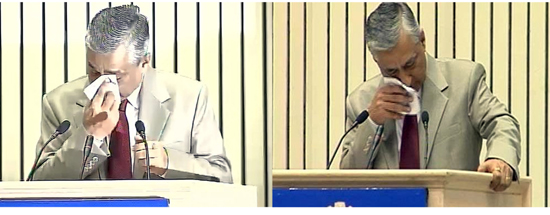NEW DELHI, Apr 24:
Chief Justice of India T S Thakur today became emotional in the presence of Prime Minister Narendra Modi, lamenting government’s “inaction” in raising the number of judges from 21,000 to 40,000 to handle mounting cases, saying, “you cannot shift the entire burden on the judiciary”.
“Nothing moves”, an unusually emotional Thakur said, recalling a 1987 Law Commission recommendation to increase the number of judges from then 10 judges per 10 lakh people to 50.
“Then comes inaction by the government as the increase (in the strength of judges) does not take place,” he said in a choked voice while addressing the inaugural session of Joint Conference of Chief Ministers and Chief Justices of High Courts here.
“…And therefore, it is not only in the name of a litigant or people languishing in jails but also in the name of development of the country, its progress that I beseech you to rise to the occasion and realise that it is not enough to criticise. You cannot shift the entire burden on the judiciary,” the Chief Justice of India, who was seen wiping his eyes on three occasions, said as the Prime Minister heard him in rapt attention.
Modi, who was not scheduled to speak as per the programme circulated by the Law Ministry, said, “I can understand his (CJI’s) pain as a lot of time has lapsed since 1987. Whatever has been the compulsions, but its better to be late than never. We will do better in the future. Let us see how to move forward by reducing the burden of the past,” he said.
He said if Constitutional barriers do not create any problems, then top Ministers and senior Supreme Court judges can sit together in a closed room to find a solution to the issue.
Modi also recalled that in one such conference he had attended as the Gujarat Chief Minister, he had flagged the issue of reducing vacation in courts and holding morning and evening courts but during lunch break during that event he was in for trouble as some judges had questioned the idea.
Later, addressing a press conference on the day’s deliberations, the CJI admitted that being emotional is his “weakness”.
“One should not be emotional. Justice Kehar (who is likely to be the next CJI) is a strong man. He will not be emotional,” he said.
In his address, Justice T S Thakur announced here that the conference adopted a resolution that Article 224 A will be invoked to allow Chief Justices of High Courts to appoint retired judicial officers as adhoc judges.
“There is a provision in the Constitution. It means that it is meant to be invoked,” he said.
Article 224 A of the Constitution states that the Chief Justice of a High Court, with the previous consent of the President (Centre), request any person who has held the office of a judge of that court or any other High Court to sit and act as a judge of the High Court for that State.
There are nearly 3 crore cases pending before the judiciary, including the Supreme Court, the 24 high courts and various subordinate courts.
He said these adhoc judges will tackle criminal cases where appeals have not been heard for the past five years.
These judges will be appointed for a period of two years or upto the time they attain the age of 65.
The CJI said these judges can also preside over ‘holiday courts’ on Saturdays and Sundays
“The Supreme Court collegium will respond next week to Government on the revised memorandum of procedure, a document to guide appointment of judges to the apex court and the High Courts, Chief Justice of India T S Thakur said today”.
He said the document, prepared by the Government to enhance transparency in judicial appointments, will be sent back to the Centre next week with the comments of the SC collegium.
Thakur said External Affairs Minister Sushma Swaraj, who headed the Group of Ministers to draft the memorandum, had spoken with him on whether the collegium was ready with its response.
He said Swaraj was abroad and the SC judges were busy with their retreat at Bhopal and the Chief Minister-Chief Justices conference.
“Now she is back. We will meet her and give our comments,” he said addressing a press conference on the decisions taken at the conference of Chief Ministers and Chief Justices of High Courts held here.
On whether the judiciary was ‘okay’ with the text of the memorandum, Justice Thakur said the core of the document, based on a Supreme Court judgment, will remain “unaltered” that the collegium will make a recommendation.
The Chief Justice said following the Law Commission’s recommendation, the Supreme Court in 2002 had also supported increasing the strength of the judiciary. A Parliamentary Department Related Standing Committee on Law then headed by Pranab Mukherjee had also recommended taking the judge to people ratio to 50 from 10.
The CJI also spoke of the “tug-of-war” that goes on between the Centre and the States over funding, infrastructure and other issues.
As of today, the judge to people ratio stands at 15 judges to 10 lakh people which is way less as compared to the US, Australia, the UK and Canada.
Referring to the pressures Indian judges face, Justice Thakur said from a Munsif to a Supreme Court judge, the average disposal in India is 2,600 cases per annum as compared to 81 cases per annum in the US. (PTI).
Trending Now
E-Paper


